Franksgiving 2024: Cutting the Mustard
Finding Hot Dogs in the Land of Badgers and Bratwurst-Plus an Audience With the Queen (of Wien).
Franksgiving 2024 found us, once again, in the Midwest. Last year, we tooled around Chicago, one of the United States’ mighty sanctuary cities of Hot Doggery. This year, we chose a more unlikely target: Madison, Wisconsin.
Madison is known for a great many fine things: One of the most beautiful and largest capitol buildings in the nation; lovely lake life; Wisconsin Badgers games; an unbeatable bicycle culture; and as the birthplace of The Onion. But it is not known for hot dogs. Instead, Madison is home to the world’s largest bratwurst festival, held annually on Memorial Day weekend.
So why did we go to Madison? Two reasons. Our friend (and The Mix subscriber!) Brian Bartels has a bar there called the Settle Down Tavern, and that bar sells three different kinds of hot dogs. The second reason speaks for itself: The National Mustard Museum.
Mustard is the one indispensable hot dog condiment. Most, if not all, of the classic hot dog stands in the country put out a frankfurter festooned with yellow or brown mustard. (The main exception is places that specialize in chili dogs or chili-cheese dogs, where so much flavor is piled on already that mustard is not needed.)
As you might suspect with such a quirky enterprise, the Mustard Museum has an unusual reason for being. It was founded by Barry Levenson, who is not the film director (different spelling), but a former assistant attorney general of Wisconsin. Tragically, for a man who has made his life in Wisconsin, Levenson is a fan of the Boston Red Sox. In 1986, the Red Sox famously lost the World Series to the New York Mets. Levenson was inconsolable. He apparently found an outlet for his anger and dejection in mustard. He already had a collection of a dozen jars of different brands. Now, he dove in head first, eventually gathering thousands of mustards, as well as much mustard memorabilia.
The Museum opened in the town of Mount Horeb in 1992. In 2009, it moved to its current location in an old cream-brick house in Middleton, which is a cute suburb west of Madison.
“Mustard Museum” is a bit of a misnomer. It’s more of a mustard store with a small museum in the basement. The store is impressive. You can purchase mustards from all over the United States and the world. It’s doubtful there is a place in the country that sells more kinds of mustard. Many of these are packaged in thematic gift boxes of three, five or six jars. There is also a mustard tasting bar where you can try dozens of kinds of mustard, making your shopping choice easier.
As for the museum, it has a healthy sense of humor about itself. For instance, there are a series of parody artworks in which mustard plays a prominent role in some of the great paintings of all time. (“The Persistence of Condiments” by Dali, “The Birth of Flavor” by Botticelli, etc.) You can pose with a gigantic plush costume of a bottle of French’s yellow mustard. A small model of the Oscar Meyer Wienermoble makes an appearance. And then there’s the world’s only mustard vending machine. It’s a wonder, though the selection is limited only to varieties of Silver Spring, a Wisconsin brand.
The museum is not terribly interested in mustard education. However, if you persist, it’s possible to learn a thing or two about this most historical and ubiquitous of condiments. Here are a few facts I collected:
Like bitters and amari, mustard has both a culinary and medicinal history; mustard plasters and mustard baths were once popular cure-alls.
There are three kinds of mustard seeds worldwide: yellow, brown and black, which originated in the Middle East and is used in Indian cuisine.
What we know as yellow mustard used to be called “salad mustard” and was not yellow at all. The current yellow mustards owe their color to the addition of turmeric.
Dijon mustard is not a protected name; it can be made anywhere, not just in Dijon; but it must be made with brown or black mustard seed.
Canada produces more mustard than any other country.
The phrase “cutting the mustard” derives from the one-time practice of mustard growers cutting down stalks with a small hand sickle. It was hard work. Thus, if you’re not up to any particular task, you’re not “cutting the mustard.”
Most of the real estate in the museum is taken up by glass display cases filled with Levenson’s collection of empty mustard bottles, just, tins and pots. The array of names and labeling is fascinating. Though there are some major brands that dominate the field (French’s, Gulden’s, Grey Poupon and Colman’s, which gets its own display case), mustard remains a very multifarious foodstuff, where any independent can still have a go at it and achieve success in some small way.
Because of this, any and every name has been used over time. A few: Royal Dutch Mustard, Nash’s Happy Time Mustard, Coleen’s Tough Times Sweet Cracked Mustard, Big Mike’s Performance Mustard, Original Beer Barrel World’s Hottest Fire Mustard, Courthouse Mustard, Time O’Day Mustard, Cowboy By Choice Rodeo Kick and, my favorite, Teen Queen Pure Ground Mustard.
Settle Down Tavern didn’t open until 3 p.m., so we had some time to kill after leaving the Mustard Museum. For whatever reason, all Madison cocktail bars open at 4 p.m. So we headed to one of the few bars that opened early, Caribou Tavern, a small, narrow dive with some choice neon, on E. Johnson Street, next door to a laundromat.
Caribou is a Madison icon, open since 1970 and proudly displays the scuffiness of its 54 years in business. Its patrons are equally scruffy. A man behind me peppered his video-game play with as many f-bombs as he could muster. The scrawny threesome to our left were bit players straight out of “Breaking Bad.” The remaining patrons were Badgers fans, donned head to toe in red, hoping for the best in that day’s game against Minnesota.
A great advantage of the Caribou is that, in old-school tavern style, it has a full food menu. A quick scan of the menu revealed that they served a hot dog for $3.50. This was an unexpected Franksgiving bonus!
There were two women behind the bar, both obviously old hands at their jobs. One handled the drink orders, the other the grill. The first made me my Brandy Old-Fashioned. The second grilled up the thick beef frankfurter and chopped white onions that went into my bun. The dog arrived in a paper boast with pickles on the side. Two kinds of Lakeside Mustard—another Wisconsin brand, made in St. Francis—were set on the counter before us.
You can buy Lakeside at the Mustard Museum.
We arrived at the Settle Down, on the dot at opening time 3 p.m., but the bar was already full. Wisconsin bars open when they want to open and close when they want to close. Half of the customers were Badgers fans nursing their wounds. Their team had lost.
We settled down into a corner table and were soon joined by owner Bartels. The last time we’d seen him was on our first visit to Settle Down. It was August 2021 and Covid was still raging on. We sat outside at a table on the sidewalk with my son Asher and my Madison-based cousins Betsy and Nann. Despite the circumstances, Brian was the consummate host. At the time, he showed me the space that was to become his second bar, Oz by Oz. Since then, it had opened and Bartels had opened yet a third place, a neo-supper club called Turn Key Supper Club. He’d also bought a house. Life goes on.
Settle Down goes all in on hot dogs. There are three choices. There’s the Ripper Style, a deep-fried dog in the New Jersey style. There’s a chili cheese dog, which needs no explanation. And there’s the Green & Gold, a reference to the Green Bay Packers, the all-consuming passion of every right-living, true-blooded Wisconsinite. The gold is beer cheese. The green is jalapeño peppers. An additional topping is crispy onions.
Of course, I went with the Green & Gold. When in Rome. It was delicious and hearty, with just enough kick from the peppers. Jersey native Mary Kate had the simple Ripper, which she dressed to her liking. The atmosphere at Settle Down was so convivial, we could have stayed all night. But we had a Madison bar crawl planned (which you’ll learn all about on Friday in The Mix’s latest “On a Toot!”). So we stepped out of the bar into the frigid, flurry-filled Wisconsin air. This had surely been the coldest Franksgiving we’d experienced.
We missed our two sons, Asher and Richard. During past Franksgivings, we had been joined by either one or both of them in our adventures. But circumstances prevented that from happening this year.
But we knew they were happy. While at Settle Down Tavern, a text came from my son Asher. He and Richard had settled down at PDT in Manhattan and were feasting on the bar’s famous hot dogs—including Richard’s order of a Simonson Dog. All was right with the world.
We hope you had a happy and toothsome Franksgiving, too! If you did, please leave a comment detailing your experiences below.
A Interview With the Queen of Wien
While prepping for Franksgiving, Mary Kate interviews Janet Riley, the former President of the National Hot Dog and Sausage Council (NHDSC), and self-proclaimed “Queen of Wien” and all-around hot dog champion. The exchange is below:
The Mix: When were you with the National Hot Dog Council?
Janet Riley: I was the senior vice president of public affairs at the American Meat Institute and President of the National Hot Dog and Sausage Council. I was with the Institute for 28 years.
What were your responsibilities there?
JR: I fulfilled an array of communications responsibilities—edited newsletters, managed web sites, served as a media spokesperson, ran crisis management efforts, assisted members with communications needs. While there, I had the chance to write the first “Hot Dog Etiquette,” which we brought to life in a video. I also had the chance to appear on “Martha Stewart,” “The Daily Show” and many other outlets to spread the hot dog gospel. It's a serious role that comes with great responsibility.
If you can believe it, I took calls round the clock from consumers on my cell asking me timeless questions like, "Why can't I have ketchup on my hot dog?" (We all have to grow up some time), "Is a hot dog a sandwich?" (NO! Calling a hot dog a sandwich is like calling the Dalai Lama just a guy), and "What's really in a hot dog? (What's on the label—nothing mysterious).
I also issued important statements on topics like the outrageous and violent attack on Tiger Woods with a sacred hot dog that was misused as a weapon. (He was putting at the time!)
Did you like hot dogs before you got that job?
JR: Oh yes! I was raised in Chicago and it's pretty much a requirement there. My mother told a story about me having an ear operation when I was six. When she brought me home from the hospital, I laid in the back seat of the car and told her I couldn't wait for her good home cooking. She asked what I wanted her to make, and I told her "Oscar Mayer Wieners and Campbell's Chicken Noodle Soup."
Of course, in those days I topped my dog with ketchup, but when I turned 18 and could vote, I ceased the childish ketchup-on-hot-dogs behavior.
JR: What do you like about hot dogs?
Hot dogs are like a canvas—you can personalize them according to your own tastes and often the city where you were raised. I love how passionately people feel about their own brands and style of topping. You can't have a civil discussion with a New Yorker and a Chicagoan about which city has better dogs. (Obviously, it's Chicago.)
Here's a fun fact: Chicago's dogs were originally called Depression Sandwiches. The city has the most topped dog in the country and I'm told that the origins of all those toppings came from a sense of competition among vendors who started adding items to attract more customers. Now you have an incredibly balanced meal, complete with an array of vegetables, when you eat a Chicago Dog.
What are your favorite places to go for a hotdog?
JR: In Chicago, I'm a Portillo's fan. In D.C., where I live now, I adore Ben's Chili Bowl. Chili Dogs are among my favorite styles.
Now that you know about it, will you be celebrating Franksgiving?
JR: Absolutely. It's a perfect day for an easy delicious hand held food that you can enjoy while placing those Black Friday orders.
IN MEMORIAM: Longtime Paris-based cocktail journalist Forest Collins died unexpectedly in Dubai last week, according to Drinks International. She was 54. Collins first made her mark with her “52 Martinis” blog in which she tracked the cocktail scene in Paris, making her one of the earliest voices in championing that city’s cocktail bars. She was the The World's 50 Best Bars Academy Chair for France and last year authored the book Drink Like a Local: Paris. Forest was busy working on that book when I first met her, in Milan, in 2022. I knew of her before then, having interviewed her previously for The New York Times. She was kind, modest, warm and approachable. She will be missed.
Odds and Ends…
The Tom and Jerry Room inside Bryant’s Cocktail Lounge in Milwaukee opened for business last Friday. Check with the bar for operating hours… Longtime cocktail writer Eric Felten reported that one of the most cherished Martini quotes of all time may be apocryphal… Ugly Baby, the popular Thai restaurant in Brooklyn, will close its doors on Dec. 24. Buttermilk Channel, another staple in the Carroll Gardens neighborhood, will close on Dec. 31… Smith’s Bar, which has held down a corner of Hell’s Kitchen in Manhattan for 70 years, splashing Eighth Avenue with neon nightly, has closed.. From Dec. 2nd to 5th, the Temple Bar will bring the bygone Carnegie Deli back to life, hosting the bygone classic sandwich shop in its "Deli After Dark" pop-up. This limited-time collaboration culminates on National Repeal Day, December 5th… Eater published Trisha Gopal’s ode to the kringle, the pastry of the city she grew up in, Racine, Wisconsin.




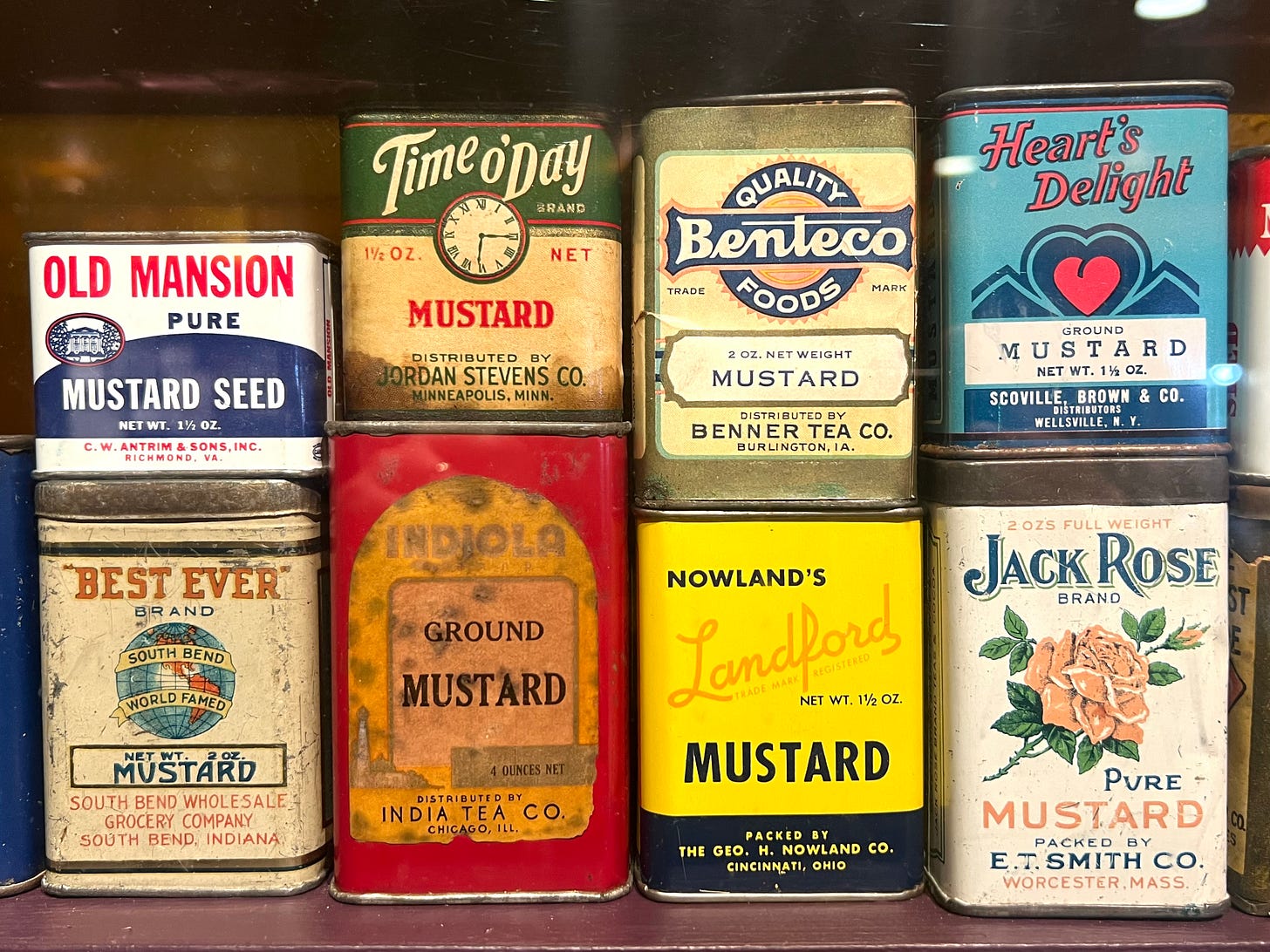
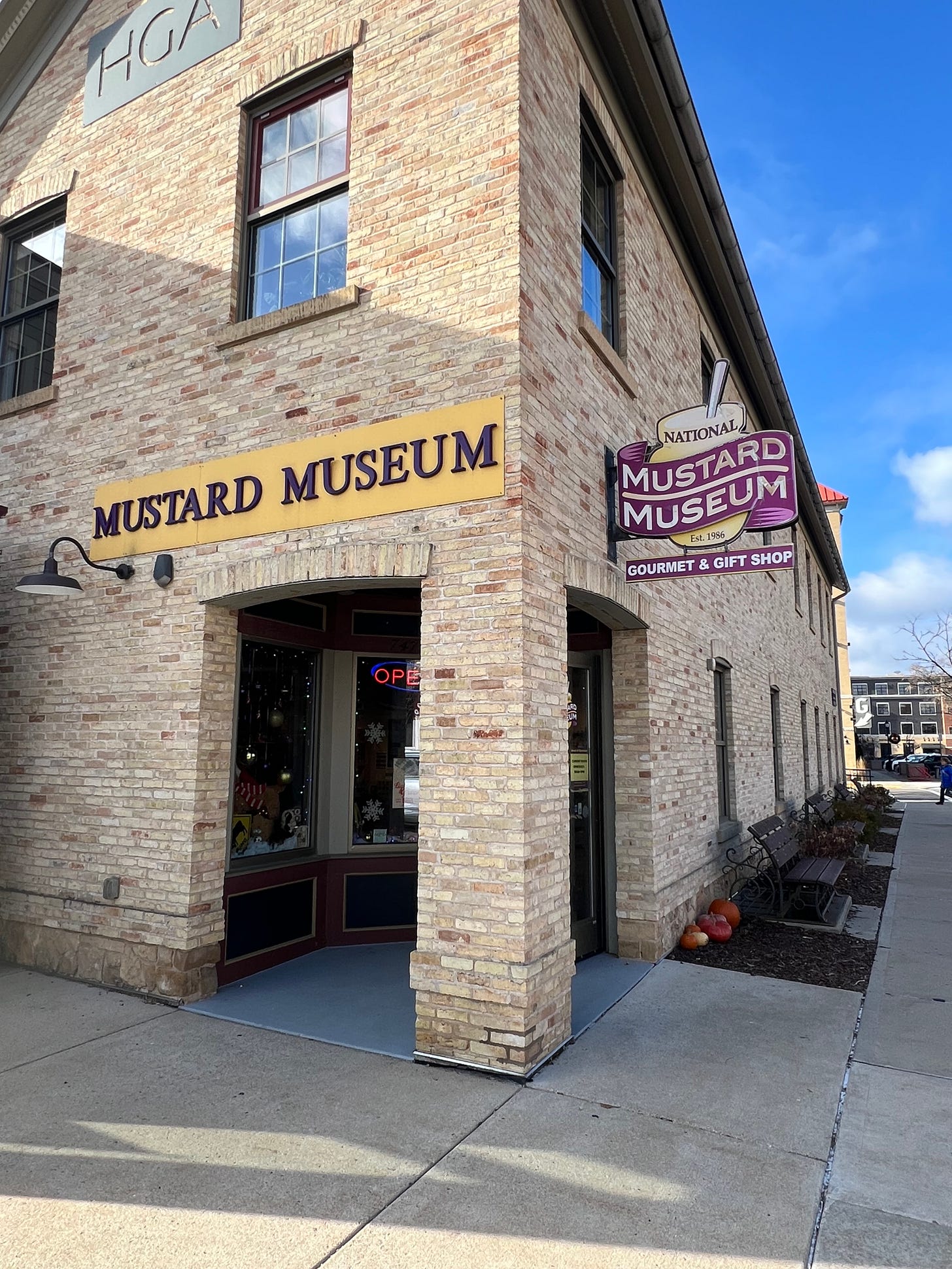




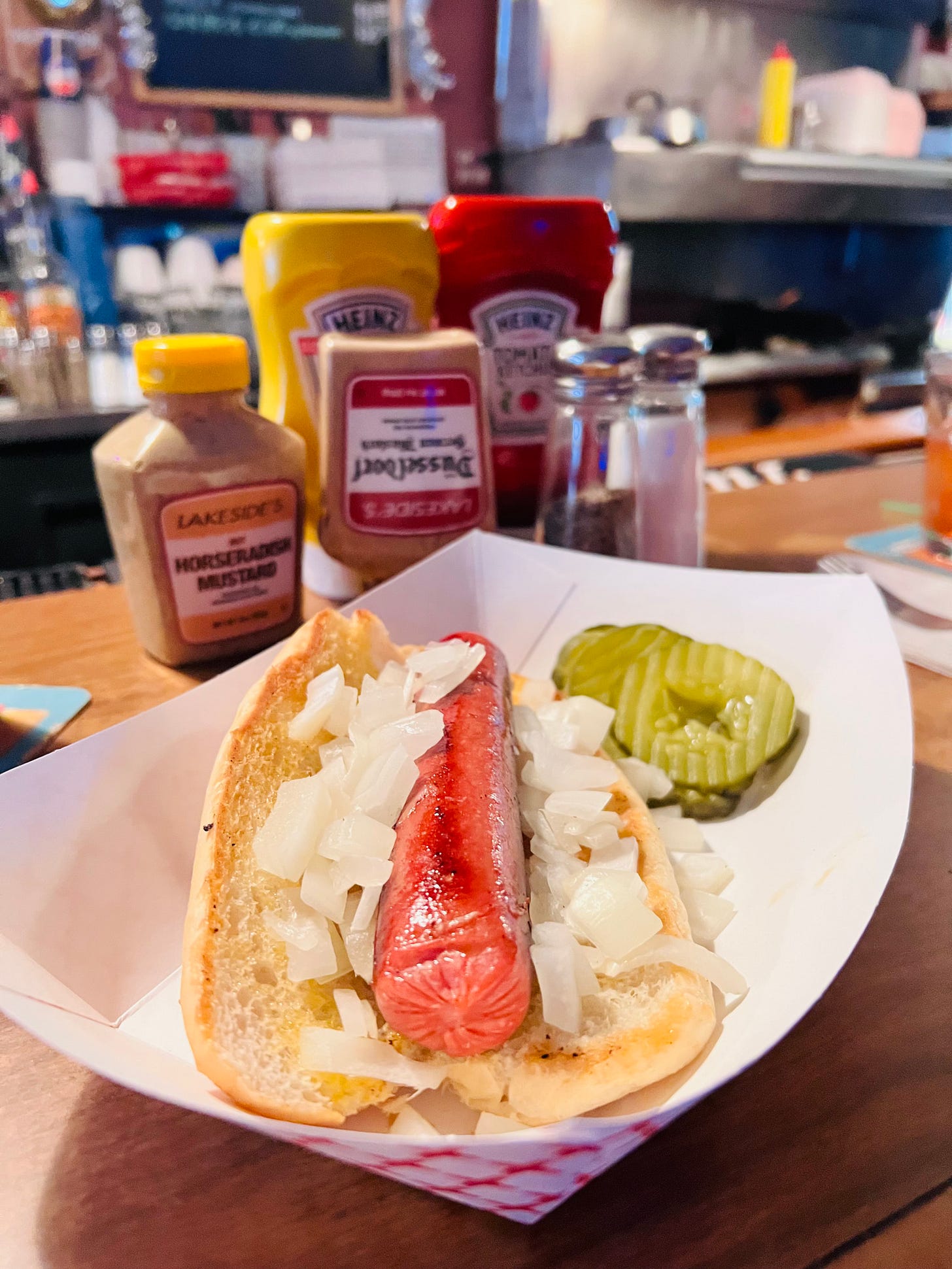
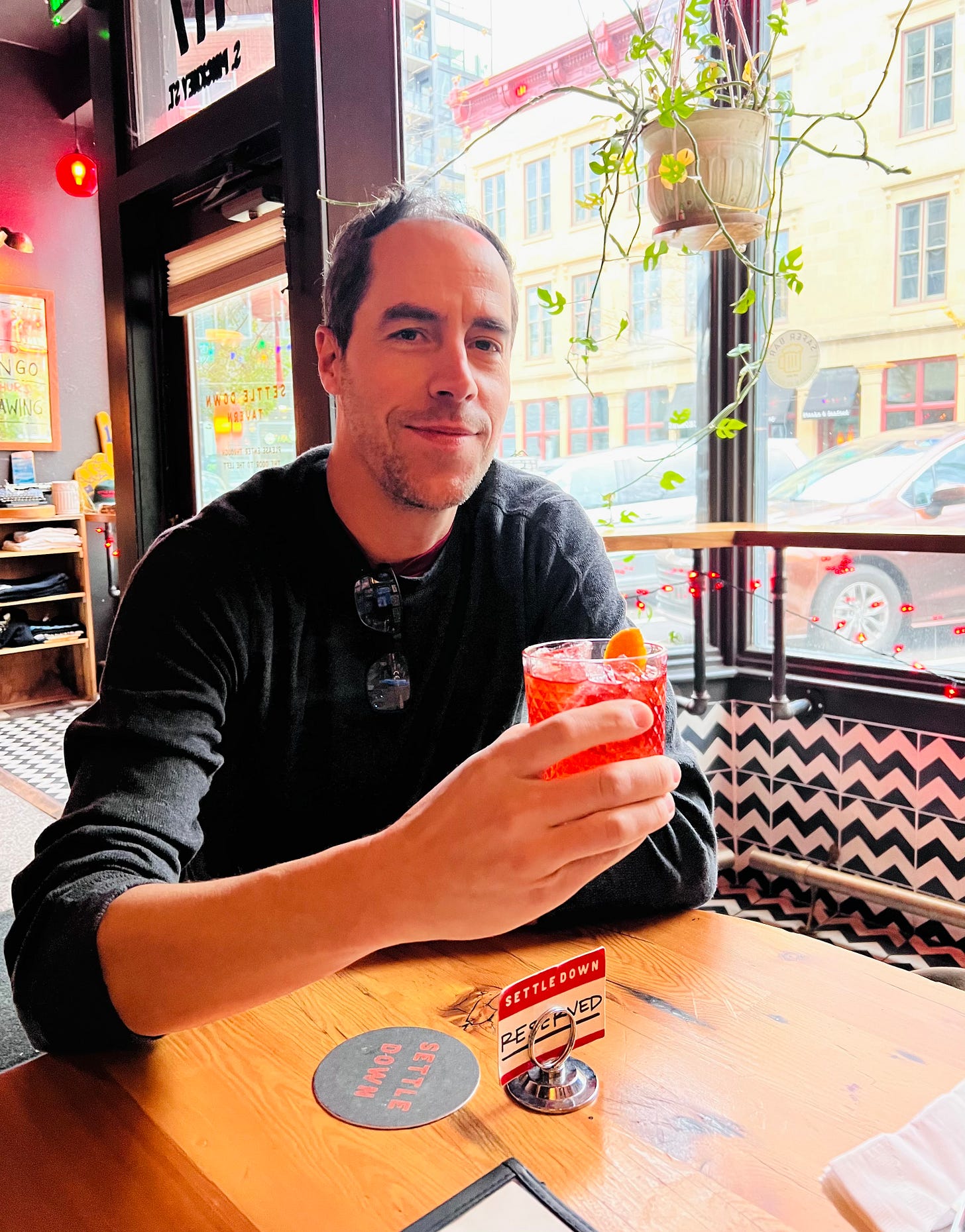
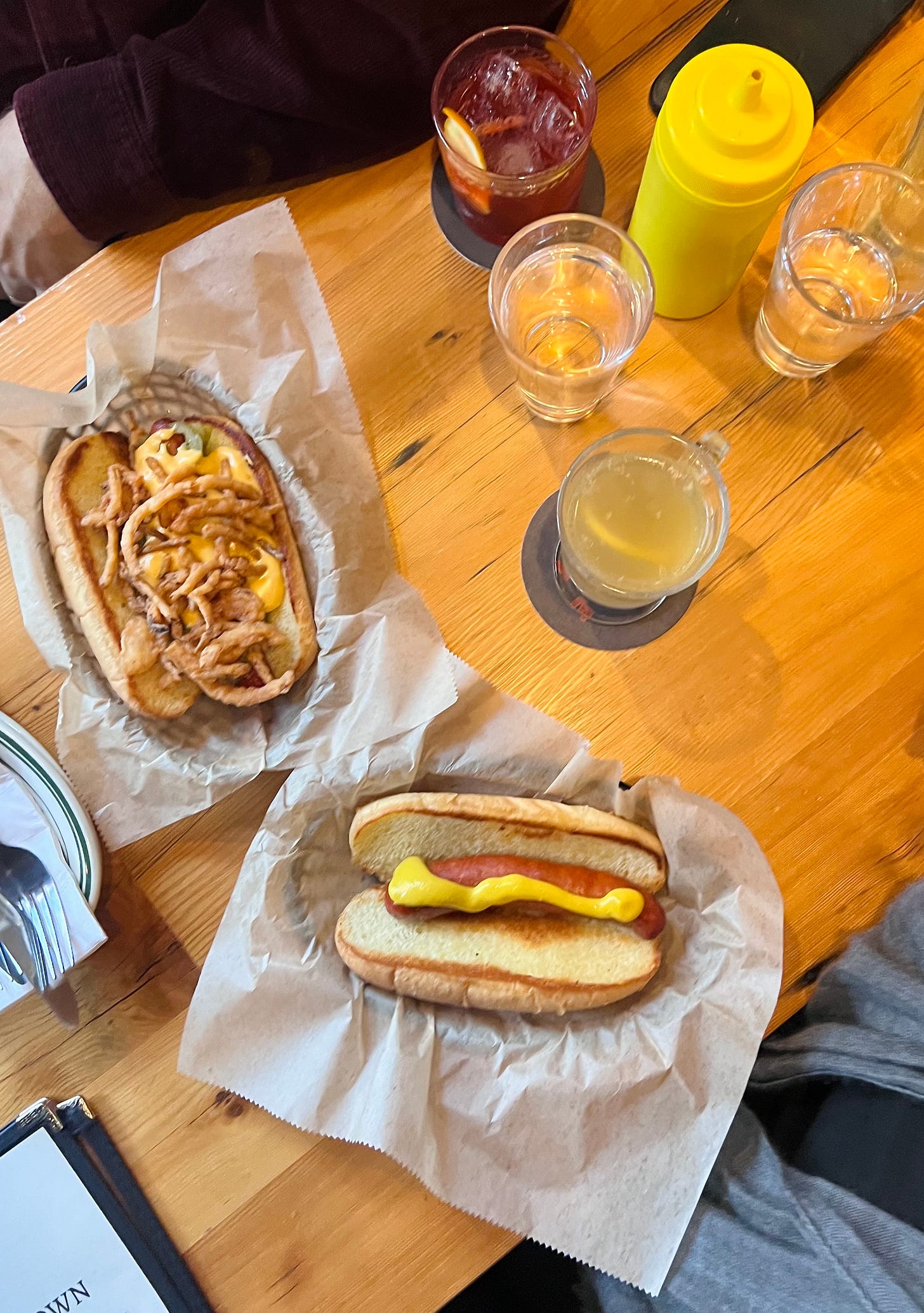



I really loved Franksgiving this year. Everyone seemed to enjoy the break from Thanksgiving, which is why we did it in the first place. So nice to see old friends (Brian) and make new ones (Janet 👸🌭)
I just witnessed one of those Swiss mustard dispensers in action at the Kristkindlmarket in Chicago last week. It’s quite hilarious.